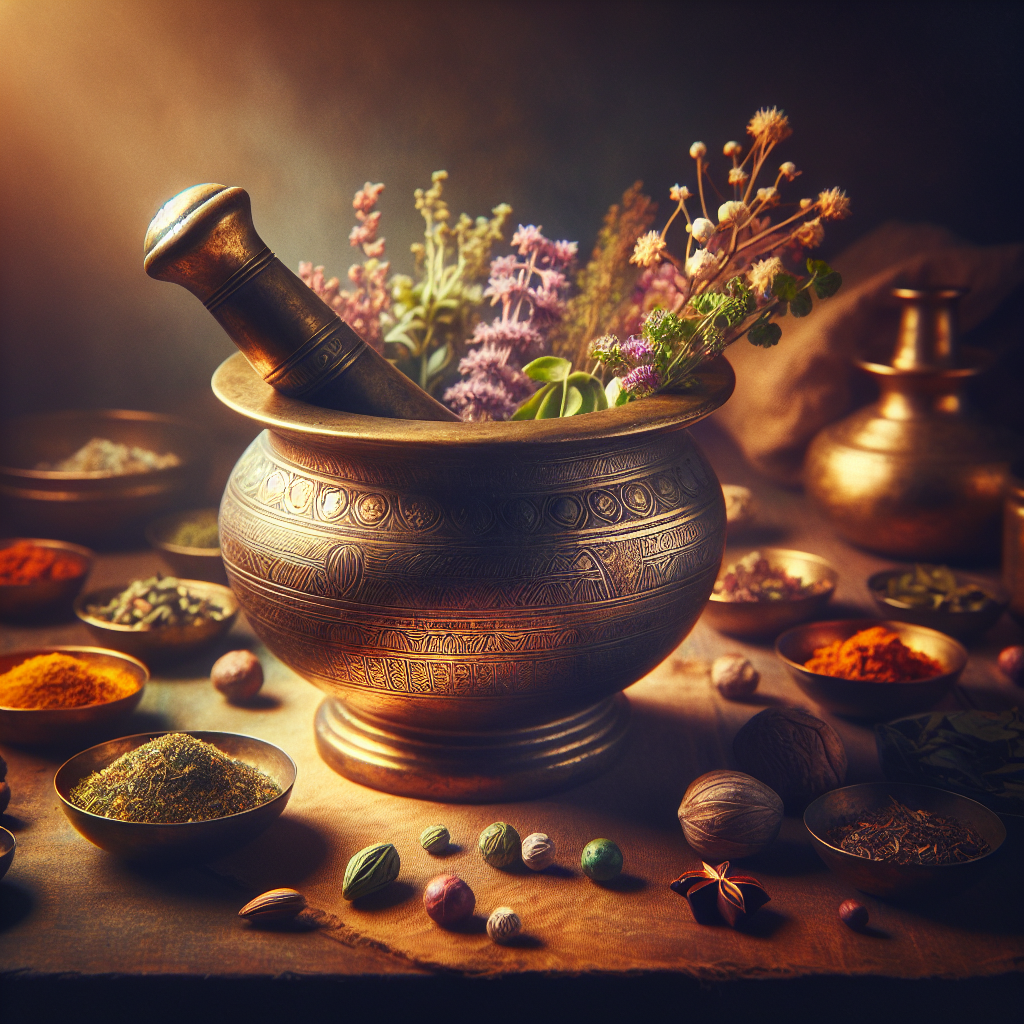Do you find yourself drawn to natural remedies and holistic approaches to wellness? If so, you may have come across the term Ayurveda. But what exactly is Ayurveda? In simple words, Ayurveda is an ancient holistic healing system that originated in India thousands of years ago. It focuses on achieving optimal health and balance through a combination of personalized diet, lifestyle choices, herbal remedies, and spiritual practices. In this article, we will explore the fundamental principles of Ayurveda and how it can benefit your overall well-being. So, let’s embark on a journey to discover the essence of Ayurveda and its profound wisdom. Ayurveda, which translates to “the science of life,” is an ancient holistic healing system that originated in India thousands of years ago. It is a comprehensive approach to health and well-being that focuses on balancing the mind, body, and spirit. Ayurveda views each individual as unique and treats them accordingly, taking into consideration their constitution, current imbalances, and the interconnectedness of their physical, mental, and emotional health.

Origin and Definition
Ayurveda is believed to have originated over 5,000 years ago and is considered one of the oldest medical systems in the world. The ancient wisdom of Ayurveda was passed down orally through generations before being documented in ancient texts such as the Charaka Samhita and the Sushruta Samhita. These texts serve as the foundation of Ayurvedic principles and practices.
The term “Ayurveda” itself is composed of two Sanskrit words: “Ayur,” meaning life, and “Veda,” meaning knowledge or science. Thus, Ayurveda can be understood as the science of life. It encompasses a wide array of knowledge, including herbal medicine, nutrition, lifestyle practices, meditation, and yoga.
Principles of Ayurveda
Ayurveda is based on several fundamental principles that guide its approach to health and healing. One of the core principles is the belief that the body and mind are interconnected and influence each other’s well-being. Ayurveda recognizes that each individual has a unique constitutional makeup or “Prakriti” that determines their physical and mental characteristics, strengths, weaknesses, and susceptibility to certain diseases.
Another principle of Ayurveda is the concept of “Vikriti,” which refers to the state of imbalance or disease. According to Ayurveda, disease arises when there is an imbalance in the three doshas, which are the foundational energies that govern all physical and mental processes in the body.
Additionally, Ayurveda emphasizes the importance of maintaining balance in one’s lifestyle, including daily routines, diet, exercise, sleep patterns, and stress management. The aim is to align oneself with the natural rhythms of the universe, as Ayurveda believes that good health is achieved by living in harmony with nature.
Ayurvedic Philosophy
At the core of Ayurvedic philosophy is the belief that the body possesses an innate capacity to heal itself. Ayurveda views health as a dynamic state of balance in which all bodily systems are functioning optimally, and disease as a state of imbalance or obstruction in the body’s natural healing processes.
According to Ayurveda, the human body is composed of five elements: space (Akasha), air (Vayu), fire (Agni), water (Jala), and earth (Prithvi). These elements combine to form three doshas: Vata, Pitta, and Kapha. Each dosha has specific qualities and functions within the body, and an imbalance in these doshas is believed to be the root cause of disease.
By understanding and addressing the underlying imbalances in the doshas, Ayurveda seeks to restore harmony and promote optimal health. It emphasizes a personalized approach to treatment that takes into account an individual’s unique constitution, lifestyle, and environment.
Understanding Doshas
The doshas, Vata, Pitta, and Kapha, are the foundational energies that govern all physical and mental processes in the body. They are responsible for maintaining balance, nourishing the tissues, and eliminating waste.
Vata dosha is composed of the elements space and air. It is responsible for movement, communication, and creativity. When Vata is in balance, it promotes flexibility, vitality, enthusiasm, and mental clarity. However, an excess of Vata can lead to dryness, anxiety, restlessness, and digestive disturbances.
Pitta dosha is composed of the elements fire and water. It governs metabolism, digestion, and transformation. When Pitta is in balance, it promotes intelligence, courage, passion, and a strong digestive fire. However, an excess of Pitta can manifest as anger, inflammation, heartburn, and excessive heat in the body.
Kapha dosha is composed of the elements water and earth. It provides structure, stability, and lubrication to the body. When Kapha is in balance, it promotes strength, stability, compassion, and a sense of groundedness. However, an excess of Kapha can lead to weight gain, lethargy, congestion, and attachment.
Tridosha Constitution
Each individual has a unique combination of the three doshas, known as their Prakriti or constitutional type. The three doshas can be present in varying proportions, resulting in different body types and personality traits.
Vata Constitution:
A person with a dominant Vata constitution tends to have a slender build, dry skin, and a tendency towards coldness. They are often creative, energetic, and adaptable but may experience anxiety, irregular digestion, and difficulty sleeping when imbalanced.
Pitta Constitution:
A person with a dominant Pitta constitution usually has a medium build, a warm complexion, and strong digestion. They are typically intelligent, ambitious, and have a strong appetite for both food and knowledge. However, when Pitta is imbalanced, they may experience irritability, acidity, skin rashes, and inflammation.
Kapha Constitution:
A person with a dominant Kapha constitution often has a sturdy build, soft skin, and a tendency towards heaviness. They are generally calm, nurturing, and compassionate. However, they may also experience lethargy, weight gain, congestion, and attachment when Kapha becomes imbalanced.
Characteristics of Each Body Type
In addition to the physical and mental characteristics associated with each dosha, Ayurveda defines specific traits and tendencies for each body type. These characteristics provide further insight into an individual’s constitution and help guide personalized treatment approaches.
For a Vata-dominant individual, physical traits may include a light frame, prominent joints, dry skin, thin hair, and cold hands and feet. They may have a quick mind, be talkative, creative, and sensitive to cold temperatures. However, when imbalanced, Vata types are prone to anxiety, dry skin, constipation, and insomnia.
Pitta-dominant individuals often have a medium build, a strong metabolism, warm and oily skin, and a tendency towards hair loss or premature graying. They are often intelligent, ambitious, and have good leadership qualities. However, when Pitta is imbalanced, they may experience irritability, inflammation, heartburn, and sharp hunger pangs.
Kapha-dominant individuals typically have a heavy build, thick and oily skin, strong muscles, and a tendency towards weight gain. They are generally calm, loving, and nurturing, with a slow but steady approach to life. However, imbalances in Kapha can manifest as sluggishness, weight gain, congestion, and emotional attachment.

Understanding the Pancha Mahabhutas
Ayurveda recognizes that all matter in the universe, including the human body, is composed of five elements or “Pancha Mahabhutas.” These elements are space (Akasha), air (Vayu), fire (Agni), water (Jala), and earth (Prithvi). Each element has specific qualities and functions, and their balance within the body is crucial for overall health and well-being.
Space (Akasha):
Space is the subtlest of the five elements and represents the openness and expansiveness found in the universe. In the body, space provides the essential background for all cellular and molecular interactions. It allows for movement, communication, and spaciousness within the body and mind.
Air (Vayu):
Air represents motion and movement. It is responsible for the movement of the doshas, as well as the circulation of blood, breath, and thoughts. Air provides the dynamic energy needed for all bodily functions and helps to maintain flexibility and agility.
Fire (Agni):
Fire represents transformation and metabolic processes. It is responsible for digestion, absorption, and assimilation of food, as well as the transformation of thoughts and emotions. Fire provides the radiant energy needed for all metabolic activities in the body.
Water (Jala):
Water represents fluidity and cohesion. It is present in all bodily fluids and tissues, providing hydration, lubrication, and nourishment. Water also helps to maintain the integrity of cellular structures and supports the process of detoxification.
Earth (Prithvi):
Earth represents solidity and stability. It provides the grounding and structural support for the body, as well as the strength and endurance needed for physical activities. Earth also represents the densest and heaviest aspect of the body.
Prakriti: Individual Constitution
According to Ayurveda, each individual is born with a unique constitution or Prakriti, which is determined by the proportion of the three doshas at the time of conception. Prakriti is considered a person’s natural state of balance and is determined by various factors, including parental doshas, genetics, and environmental influences.
Understanding one’s Prakriti is essential in Ayurveda, as it provides valuable insights into an individual’s physical and mental characteristics, strengths, weaknesses, and susceptibility to certain diseases. By recognizing their Prakriti, individuals can make informed choices about diet, lifestyle, and therapeutic interventions to maintain their optimal health.
Vikriti: State of Imbalance
While Prakriti represents an individual’s natural state of balance, Vikriti refers to their current state of imbalance or disease. Ayurveda recognizes that imbalances in the doshas can occur due to various factors such as improper diet, lifestyle choices, emotional stress, environmental toxins, or seasonal changes.
By assessing an individual’s Vikriti, Ayurvedic practitioners can determine the doshic imbalance that underlies their symptoms and develop a personalized treatment plan to restore balance and eliminate the root cause of the disease.

Balance and Imbalance
Ayurveda emphasizes the importance of maintaining balance in all aspects of life. When the doshas are in balance and the body is functioning optimally, individuals experience good health, vitality, and a sense of well-being. However, when the doshas become imbalanced, either individually or collectively, it can lead to the development of diseases and various health issues.
Ayurveda views disease as an expression of imbalance in the body. The aim of Ayurvedic treatment is to restore balance and harmony by addressing the underlying causes of imbalance and supporting the body’s natural healing processes. This can be achieved through a combination of dietary modifications, lifestyle changes, herbal remedies, therapies, and mind-body practices.
Diagnosis Through Observation
In Ayurveda, diagnosis is primarily done through observation and assessment of an individual’s physical appearance, body structure, speech patterns, and lifestyle habits. Ayurvedic practitioners pay close attention to physical and mental characteristics, including skin condition, hair texture, body weight, eye appearance, digestion, sleep patterns, and emotional state.
This observational diagnosis, known as “Darshana,” helps to identify the doshic imbalances, as well as specific areas of the body that may be affected. By understanding an individual’s unique constitution and current imbalances, Ayurvedic practitioners can develop a personalized treatment plan to restore balance and promote healing.
Treatment Modalities
Ayurvedic treatment approaches are multifaceted and address the root cause of imbalances rather than just the symptoms. Treatment modalities are customized based on an individual’s Prakriti, Vikriti, and specific health concerns. They may include herbal medicine, dietary recommendations, lifestyle practices, therapeutic procedures, and mind-body techniques.

Herbal Medicine
Ayurveda utilizes a vast array of herbs and herbal formulations to balance the doshas and support overall health. Herbal medicines are prepared from various parts of plants, including leaves, stems, bark, roots, flowers, and seeds. Each herb has specific qualities and healing properties that can be used to address specific imbalances and promote well-being.
Herbal medicines can be taken internally as powders, tablets, teas, or decoctions, or applied externally in the form of oils, pastes, or poultices. Ayurvedic formulations are carefully prepared to ensure synergy and enhance the efficacy of the herbs when used together.
Dietary Recommendations
Ayurveda places great importance on nutrition and considers food as medicine. The Ayurvedic diet focuses on nourishing the body, supporting digestion, and balancing the doshas. Dietary recommendations are tailored to an individual’s doshic constitution, current imbalances, and seasonal factors.
Ayurvedic dietary principles emphasize fresh, whole foods that are prepared with love and eaten in a calm and mindful manner. The diet includes a variety of fruits, vegetables, grains, legumes, dairy products, fats, spices, and herbs, each chosen for its specific qualities and therapeutic benefits.
Lifestyle Practices
Ayurveda recognizes that daily routines and lifestyle choices play a significant role in maintaining optimal health and preventing imbalances. Ayurvedic lifestyle practices, known as “Dinacharya,” help individuals align themselves with the natural rhythms of the day and the seasons.
Dinacharya includes activities such as waking up early, practicing gentle exercise or yoga, cleansing the body through techniques like oil pulling or tongue scraping, performing self-massage, taking regular breaks from work, and having a regular sleep schedule.

Panchakarma
Panchakarma is an integral part of Ayurveda and is considered the ultimate detoxification and rejuvenation therapy. It consists of five therapeutic procedures that help eliminate toxins, restore balance, and promote overall well-being.
The five procedures of Panchakarma are Vamana (therapeutic vomiting), Virechana (purgation), Basti (medicated enema), Nasya (nasal administration), and Raktamokshana (bloodletting). These procedures are performed under the guidance of trained Ayurvedic practitioners and are tailored to each individual’s unique needs.
Abhyanga: Ayurvedic Massage
Abhyanga is the Ayurvedic practice of self-massage using warm herbal oils, typically performed in the morning before bathing. Abhyanga helps nourish the tissues, improve circulation, and promote the elimination of toxins. It also has a calming effect on the nervous system, reduces stress, and enhances relaxation.
During an Abhyanga massage, warm oil is applied to the entire body in long, rhythmic strokes. The massage is usually followed by a warm bath or shower to further enhance the therapeutic benefits.
Shirodhara: Oil Therapy for the Head
Shirodhara is a deeply relaxing therapy that involves pouring a continuous stream of warm herbal oil onto the forehead. The warm oil gently flows over the “third eye” area, known as the Ajna chakra, and nourishes the scalp and hair.
Shirodhara helps calm the mind, reduce stress, improve sleep, enhance mental clarity, and promote a sense of profound relaxation. It is commonly used to alleviate headaches, migraines, anxiety, insomnia, and imbalances in the nervous system.
Nasya: Nasal Administration
Nasya is the practice of administering herbal oils, ghee, or medicated powders into the nostrils. This Ayurvedic therapy helps alleviate congestion, sinusitis, allergies, and other respiratory issues. It also supports the health of the eyes, ears, and throat.
Nasya helps to lubricate the nasal passages, clear accumulated toxins, and balance the doshas in the head and neck region. It is usually performed in the morning after nasal cleansing and can be done regularly as part of a preventive health routine.
Swedana: Herbal Steam Therapy
Swedana is a therapeutic procedure that involves the use of herbal steam to induce sweating and promote detoxification. It is often performed after an oil massage or other Ayurvedic treatments to help facilitate the absorption of herbal oils and stimulate the removal of toxins.
Swedana can be done using a simple steam bath or through specialized techniques such as steam chambers or Ayurvedic herbal poultices. It helps reduce stiffness, relieve pain, improve circulation, and promote a sense of relaxation.
Meditation and Yoga
Ayurveda recognizes the close link between the mind and body and emphasizes the importance of mental and emotional well-being in achieving optimal health. Meditation and yoga are powerful practices that help calm the mind, reduce stress, and enhance self-awareness.
Meditation involves focusing the mind on a specific object, sound, or breath to achieve a state of peacefulness and mental clarity. Regular meditation practice can help reduce anxiety, stress, and depression, as well as improve concentration, memory, and overall emotional well-being.
Yoga, on the other hand, combines physical postures, breathing exercises, and meditation to promote flexibility, strength, and balance in the body. It helps improve circulation, stimulate digestion, and enhance overall vitality.
Ayurvedic Psychology
Ayurveda recognizes the intimate connection between the mind and body and incorporates psychological principles into its approach to health and well-being. Ayurvedic psychology, known as “Manas Shastra,” explores the mind’s impact on physical health and recognizes the influence of emotional states on disease development.
According to Ayurvedic psychology, imbalances in the doshas can give rise to specific mental and emotional tendencies. For example, an excess of Vata can lead to anxiety, fear, and restlessness, while an excess of Pitta can manifest as anger, irritability, and perfectionism. Imbalances in Kapha can result in attachment, lethargy, and resistance to change.
Ayurvedic psychology aims to address these imbalances through various therapeutic interventions such as lifestyle modifications, herbal remedies, relaxation techniques, and counseling.
Ayurvedic Sleep Hygiene
Ayurveda places great emphasis on the importance of quality sleep for overall health and well-being. Adequate and restful sleep is considered essential for restoring the body’s natural balance, rejuvenating the tissues, and promoting optimal functioning of the mind and senses.
Ayurvedic sleep hygiene practices include establishing a regular sleep routine, creating a calm and conducive sleep environment, avoiding stimulating activities before bed, and adopting relaxation techniques such as meditation or gentle yoga to help prepare the mind and body for sleep. It also recommends avoiding excessive use of electronic devices and consuming heavy meals or stimulating substances close to bedtime.
Rasayana: Rejuvenation Therapy
Rasayana is a form of Ayurvedic rejuvenation therapy that aims to promote longevity, slow down the aging process, and enhance overall vitality. Rasayana therapies include specific dietary regimens, lifestyle practices, and herbal formulations that help nourish the body, strengthen the tissues, and enhance cellular regeneration.
Rasayana therapies are tailored to an individual’s unique constitution and specific health concerns. They are typically administered under the guidance of experienced Ayurvedic practitioners and can be done as preventive measures or in response to specific imbalances or health challenges.
Dinacharya: Daily Ayurvedic Routine
Dinacharya, which translates to “daily regimen,” is an essential aspect of Ayurvedic living. It provides a systematic approach to daily routines and lifestyle practices that help maintain balance, promote good health, and prevent imbalances from arising.
Dinacharya includes various activities such as waking up early, practicing self-care rituals like tongue scraping and oil pulling, performing gentle exercise or yoga, eating regular and balanced meals, and ensuring proper hydration. It also emphasizes the importance of maintaining a regular sleep schedule and engaging in activities that promote relaxation and stress reduction.
Ritucharya: Ayurveda for Seasons
Ayurveda recognizes that the seasons have a profound influence on the doshas and our overall well-being. Ritucharya, also known as “Ayurveda for seasons,” provides guidelines for adjusting diet, lifestyle, and practices according to the changing seasons.
Each season is associated with specific qualities and doshic influences. For example, winter is considered a Vata season characterized by dryness, cold, and movement, while summer is a Pitta season characterized by heat and intensity. By understanding these seasonal influences, individuals can make appropriate modifications to their routines and habits to maintain balance and prevent imbalances associated with seasonal changes.
Adopting Ayurvedic Lifestyle Practices
Ayurveda offers a comprehensive approach to health and well-being that encompasses all aspects of life. While it may seem overwhelming to incorporate all the principles and practices of Ayurveda into your daily life, adopting simple lifestyle practices can make a significant difference in your overall health and well-being.
Start by incorporating small changes, such as establishing a regular sleep routine, practicing mindful eating, engaging in regular exercise or yoga, and incorporating Ayurvedic herbs and spices into your diet. Gradually expand your knowledge and integrate more Ayurvedic practices into your daily life as you become more familiar with the principles and techniques.
Remember, Ayurveda is not a one-size-fits-all approach. It is a highly individualized system of medicine that recognizes and respects the uniqueness of each individual. By taking the time to understand your own body, its constitution, and its specific needs, you can cultivate a personalized approach to health and well-being that supports your journey towards balance and optimal health.
Integration and Coexistence
While Ayurveda is an ancient system of medicine, it can coexist and integrate with modern medicine. Ayurveda’s holistic approach to health and well-being complements the reductionist approach of modern medicine, providing a more comprehensive view of disease prevention and treatment.
Integrating Ayurveda and modern medicine can provide a more holistic and personalized approach to healthcare. Ayurvedic principles and practices can be used in conjunction with conventional medical treatments to address the underlying imbalances and promote overall well-being.
Complementary Approaches
Ayurveda offers a range of therapies, practices, and lifestyle recommendations that can support and enhance the effectiveness of modern medical treatments. For example, Ayurvedic herbal remedies can be used alongside prescription medications to reduce side effects and promote healing.
Additionally, Ayurvedic principles such as dietary recommendations, stress management techniques, and lifestyle modifications can complement modern medical treatments by addressing the root causes of imbalances and promoting overall health and well-being.
Research and Evidence
Ayurveda is an ancient tradition that has been used for thousands of years to promote wellness and treat various health conditions. While much of Ayurvedic knowledge has been passed down through generations, there is also a growing body of scientific research that supports the efficacy of Ayurvedic principles and practices.
Numerous studies have been conducted to investigate the therapeutic effects of Ayurvedic herbal formulations, dietary interventions, and lifestyle practices. These studies have shown promising results in various areas, including inflammation, stress reduction, digestive disorders, and mental health.
However, it is important to note that Ayurveda’s holistic and personalized approach to health and well-being may not always fit within the traditional framework of scientific research. Ayurveda places great emphasis on individual experiences and recognizes that what works for one person may not work for another. Therefore, further research and collaboration between Ayurvedic and conventional medical practitioners are needed to fully understand and utilize the potential of Ayurveda in modern healthcare.
In conclusion, Ayurveda offers a comprehensive and holistic approach to health and well-being that recognizes the interconnectedness of the mind, body, and spirit. By understanding and aligning with the principles and practices of Ayurveda, individuals can cultivate balance, prevent imbalances, and support their overall health and vitality. Whether it is through dietary modifications, lifestyle practices, herbal remedies, or therapeutic procedures, Ayurveda provides a personalized and integrative approach to healing and living in harmony with nature.
